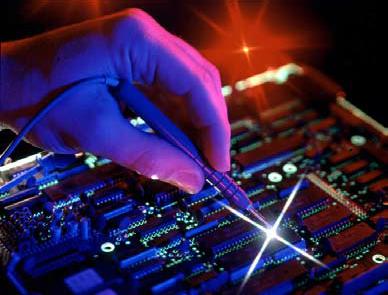Electronics Module
Electronics Module
Prepared by Sam Kinyera OBWOYA
African Virtual university
Université Virtuelle Africaine
Universidade Virtual Africana
African Virtual University
Notice
This document is published under the conditions of the Creative Commons
http://en.wikipedia.org/wiki/Creative_Commons
Attribution
http://creativecommons.org/licenses/by/2.5/
License (abbreviated “cc-by”), Version 2.5.
African Virtual University
Table of ConTenTs
I.
Electronics Module _________________________________________ 3
II. Prerequisite Course or Knowledge _____________________________ 3
III. Time ____________________________________________________ 3
IV. Materials _________________________________________________ 3
V. Module Rationale __________________________________________ 3
VI. Content __________________________________________________ 4
6.1 Overview ___________________________________________ 4
6.2 Outline _____________________________________________ 5
6.3 Graphic Organizer _____________________________________ 6
VII. General Objectives _________________________________________ 7
VIII. Specific Learning Objective(s) _________________________________ 7
IX. Pre-assessment ___________________________________________ 9
X. Teaching and Learning Activities ______________________________ 14
XI. Glossary of Key Concepts __________________________________ 149
XII. List of Compulsory Readings _______________________________ 151
XIII. Compiled List of (Optional) Multimedia Resources _______________ 153
XIV. Compiled list of Useful links ________________________________ 155
XV. Synthesis of the Module ___________________________________ 158
XVI. Summative Evaluation _____________________________________ 160
XVII. References _____________________________________________ 163
XVIII. Student Record _________________________________________ 164
XIX. Main Author of the Module _________________________________ 164
African Virtual University
I. electronics Module
By Sam Kinyera Obwoya Kyambogo University Uganda
II. Prerequisite Courses or Knowledge
The basic prerequisites for this module are the school physics that one has learnt. In
particular, knowledge of the following courses are essential for one to follow and
understand the module effectively. Some of the prerequisite courses are solids state
physics, electricity and magnetism. As a general requirement, you need the knowledge
of calculus and algebra in mathematics.
III. Time
A total of 120 hours is required for you to complete this module.
IV. Material
The materials required for the module include access to a computer, but more impor-
tantly one needs a steady access to internet. The internet will provide many of the
essential references and multimedia resources. These multimedia are important as in
some cases they serve as virtual lecturers and sources of equipment that can be used
to perform virtual experiments. However, some CD-ROMS will also be available
to supplement the use of internet. Other materials include compulsory readings and
compulsory resources that may be available at nearby bookshops or schools.
V. Module Rationale
This module is intended to provide a basic foundation of physics to students. This
will enable the students to learn the subject matter in order to explain and account for
the principles involved in electronics. The module is structured such that the learner
has to go through the activities as prescribed for maximum attainment. The overall
module will provide the student with basic ideas of what electronics is in terms of the
key components’ behaviours or characteristics and therefore will be enable to teach
most of the school physics effectively.
African Virtual University
VI. Content
6.1 Overview
Electronics is the study of the flow of charge through various materials and devices
such as, semiconductors, resistors, inductors, capacitors, nano-structures, and vacuum
tubes. All applications of electronics involve the transmission of power and possibly
information. Although considered to be a theoretical branch of physics, the design and
construction of electronic circuits to solve practical problems is an essential technique
in the fields of electronic engineering and computer engineering.
The study of new semiconductor devices and surrounding technology is sometimes
considered a branch of physics. This module focuses on engineering aspects of
electronics. Other important topics include electronic waste and occupational health
impacts of semiconductor manufacturing.
This course of electronics is intended for students enrolling for pre-service and in-
service students registering for BSc with Education and BEd degrees. As you may be
aware, Electronics forms one the back bone of modern physics. The module has six
units: Diode Circuits; Transistor Circuits; Operational Amplifiers; Digital Circuits;
Data acquisition and Process Control; and Computers and Device Interconnection.
In the first unit/activity i.e. diodes circuits, students are expected to explain charge car-
rier generation, intrinsic and extrinsic semi-conductors, formation and application of
P-N junction, and to design and analyse diode circuits (e.g, power supply circuits).
In the second unit/activity i.e. Transistor circuits, the student is expected to explain
how a Bipolar Junction Transistor (BJT) works; Design and analyse basic BJT cir-
cuits in various configurations (CE, EB, CB); Explain how a junction Field Effect
Transistor (JFET) works ; Design and analyse JFET circuits in both configurations
(CD, CS); Explain how MOSFET works and also be able to Design and analyse
MOSFET circuits.
In unit three the learning outcomes include one being able to explain the construc-
tion of operational amplifier; and to Design, analyse and synthesize operational
amplifier circuits. In unit four, i.e. Digital Circuits, the student is expected to Ma-
nipulate numbers in various bases (2,8,10,16); Apply Boollean algebra in design of
logic circuits; Design, analyse and synthesize logic circuits (multiplexer, decoders,
Schmitt triggers, flip-flops, registers). In unit five the learner will explain the opera-
tion of a transducer in various modes (strain, light, piezo, temp); Explain and apply
transducer signal conditioning processes; and to Apply conditioned signal in digital
form. Finally, in activity six, i.e. Elements of the Microcomputer 8-, 16- or 32Bit
buses, the expected learning will include explaining the systems level components
of a microprocessor.
African Virtual University
6.2
Outline
Activity 1
(20 hours)
Diode Circuits Review Energy band theory, The PN Junction and the Diode Effect,
Circuit, Applications of Ordinary Diodes
Activity 2
(30 hours)
Transistor Circuits Bipolar Junction Transistor (BJT) Common Emitter Amplifier,
Common Collector Amplifier, Common Base Amplifier. The Junction Field Effect
Transistor (JFET), JFET Common Source Amplifier, JFET Common Drain Ampli-
fier. The Insulated-Gate Field Effect Transistor. Power MOSFET Circuits. Multiple Transistor Circuits
Activity 3
(10 hours)
Operational Amplifiers Open-Loop Amplifiers, Ideal Amplifier, Approximation
Analysis, Open-Loop Gain
Activity 4
(30 hours)
Digital Circuits Number Systems, Boolean Algebra, Logic Gates, Combinational
Logic. Multiplexers and Decoders. Schmitt Trigger, Two-State Storage Elements,
Latches and Un-Clocked Flip-Flops. Clocked Flip-Flops, Dynamically clocked Flip-
Flops, One-Shot Registers
Activity 5
(20 hours)
Data Acquisition and Process Control Transducers, Signal Conditioning Circuits,
Oscillators, Analogue-to-Digital Conversion
Activity 6
(10 hours)
Computers and Device Interconnection Elements of the Microcomputer 8-, 16- or
32- Bit Buses
African Virtual University
6.3
Graphic Organizer
6.2
GRAPHIC ORGANIZER
A. Diode Circuits
Review Energy band theory,
D. Digital Circuits
The PN Junction and the Diode Effect,
Number Systems, Boolean Algebra,
Circuit Appli cations of Or dinary Diodes
Logic Gates, Combinational Logic.
Multiplexers and Decoders. Schmitt Trigger,
B. Transistor Circuits:
Two-State Storage Elements, Latches and Un-Clocked Fli p-Flops.
Bipolar Junction Transistor (BJT)
Clocked Fli p-Flops, Dynamical y clocked Flip-Flops, One-Shot Registers
Comm on Emitter Ampli fier, Comm on
Col ector Ampli fier, Comm on Base Ampli fier.
E. Data Acquisition
and Process Control
The Junction Field Effect Transistor (JFET),
Transducers,
Elect
c roni
n cs
c
JFET Comm on S ource Amplifier, JFET Common Drain Amplifier.
Signal Conditioning Circuits,
The Insulated-Gate Field Effect Transistor.
Power MOSFET Circuits. Multiple Transistor Circuits
Oscil ators,
Analogue-to-Di gital Conversion
C. Operational
Amplifiers
F. Com puters and
Open-Loop Amplifiers,
Device Interconnection
Ideal Ampli fier,
Elements of the Microcomputer 8-, 16- or 32- Bit Buses
Approximation Analysis,
Open-Loop Gain
3
African Virtual University
VII. General objective(s)
After completing the module you should be able to
• appreciate and apply basic electronic concepts and circuits
VIII. specific learning objectives
Unit
Learning objective(s)
1. Diode Circuits (20 hours)
Students should be able to
• Review Energy band theory,
• Explain charge carrier generation
• The PN Junction and the Diode
intrinsic and extrinsic semi-conductors
Effect,
• Explain formation and application of
• Circuit, Applications of Ordinary
P-N junction
Diodes.
• Design and analyse diode circuits (e.g,
power supply circuits)
2. Transistor Circuits: (25 hours)
Students should be able to
• Bipolar junction Transistor
• Explain how a Bipolar Junction Tran-
• (BJT);Common Emitter Ampli-
sistor (BJT) works
fier; Common Collector Ampli-
• Design and analyse basic BJT circuits
fier, Common Base Amplifier.
in various configurations (CE, EB,
• The Junction Field Effect Tran-
CB)
sistor (JFET), JFET Common
• Explain how a junction Field Ef-
Source Amplifier, JFET Common
fect Transistor (JFET) works (some
Drain amplifier.
theory)
• The Insulated-Gate Field Effect
• Design and analyse JFET circuits in
Transistor. Power
both configurations (CD, CS)
• MOSFET Circuits, Multiple
• Explain how MOSFET works (theory)
Transistor Circuit
• Design and analyse MOSFET circuits
3. Operational Amplifiers (10 hours)
Students should be able to
• Open loop Amplifiers,
• Explain the construction of operatio-
• Ideal Amplifiers, Apporoxima-
nal amplifier
tion Analysis, Ope-loop Gain.
• Design, analyse and synthesize opera-
tional amplifier circuits
African Virtual University
4. Digital Circuits (30 hours)
Students should be able to
• Number systems, Boolean Alge-
• Manipulate numbers in various bases
bra, Logic Gates,
(2,8,10,16)
• Combinational Logic,
• Apply Boollean algebra in design of
• Multiplexes and decoders, Sch-
logic circuits
mitt Trigger, Two-State storage
• Design, analyse and synthesize logic
elements,
circuits (multiplexer, decoders, Smch-
• Latches and un-clocked flip-
mitt triggers, flip-flops, registers)
flops;
• Dynamically clocked flipiflops,
• One-shot registers
5. Data acquisition and Process
Students should be able to
Control (20 hours)
• Explain the operation of a transducer
• Transducers, Signal Conditioning
in various modes (strain, light, piezo,
• circuits, Oscillators, Analogue-
temp)
to-Digital Conversion
• Explain and apply transducer signal
conditioning processes
• Apply conditioned signal in digital
form
6. Computers and Device Inter-
• Explain the systems level components
connection (15 hours)
of a microprocessor
• Elements of the Microcomputer
8-, 16- or 32- Bit Buses
African Virtual University
IX. Pre-assessment
Are you ready to Learn Electronics?
Title of Pre-assessment : ELECTRONICS
Rationale : The pre-assessment is intended to determine how much one remembers
and what one knows about electronics which was done at school and therefore to
orient the mind of the learner of the amount of work expected to be covered during
the course. The pre-assessment is not intended in anyway to discourage the learner,
but rather to motivate one to start the course with a lot of readiness for the challenges
ahead.
9.1
Self Evaluation Associated With Electronics
1 The resistance of the semiconductor materials in a photoconductive cell varies
with the intensity of incident light.
a. directly
b. inversely
c. exponentially
d. log arithmetically
2 A solar cell operates on the principle of
a. diffusion
b. recombination
c. carrier flow
d. photovoltaic action
3 Which of the following devices has the highest sensitivity?
a. photoconductive cell
b. photovoltaic cell
c. photodiode
d. phototransistor
4 In LED, light is emitted because
a. recombination of charge carriers takes place
b. light falling on the diode gets amplified
c. light gets reflected due to lens action
d. diode gets heated up
African Virtual University 0
5 A transistor series voltage regulator is called emitter-follower regulator because
the emitter of the pass transistor follows the voltage.
a. base
b. input
c. output
d. collector
6 A switching voltage regulator can be of the following type:
a. inverting
b. step-up
c. step-down
d. all of the above
7 An ideal voltage regulator has a voltage regulation of
a 0
b. 1
c. 50
d. 100
8 Electronic devices that convert dc power to ac power are called
a inverters
b. rectifiers
c. converters
d. transformers
9 The output of a half-wave rectifier is suitable only for
a. running car radios
b. running ac motors
c. running tape-recorders
d. charging batteries
10 When used in a circuit, a Zener diode is always
a. forward biased
b. reverse-biased
c. connected in series
d. troubled by overheating
African Virtual University
11 Zener diodes are used primarily as
a. rectifiers
b. amplifiers
c. oscillators
d. voltage regulators
12 An op-amp shunt regulator differs from the series regulator in the sense that its
control element is connected
a. series with line resistor
b. parallel with line resistor
c. parallel with load resistor
d. parallel with input voltage
13 The digital systems usually operates on……system.
a. octal
c. binary
d. decimal
e. hexadecimal
14 The cumulative addition of four binary bits (1 + 1 + 1 + 1) gives
a. 1111
b. 111
c. 110
d. 11
15 The result of binary multiplication 111 x 10 is
2
2
a. 1101
b. 0110
c. 1001
d. 1110
16 A FETs have similar properties to
a. PNP transistor
b. NPN transistor
c. thermionic valves
d. Unijunction transistor
African Virtual University
17 The voltage gain of a given common-source JFET amplifier depends on its
a. input impedance
b. amplification factor
c. dynamic drain resistance
d. drain load resistance
18 The extremely high input impedance of a MOSFET is primarily due to the
a. absence of its channel
b. negative gate-source voltage
c. depletion of current carriers
d. extremely small leakage current of its gate capacitor
19 The main use of an emitter follower is as:
a. power amplifier
b. impedance matching
c. low-input impedance
d. follower of base signal
20 The smallest of the four h- parameters of a transistor is:
a. hi
b. hr
c. h0
d. hf
Answer Key
1. B
11. D
2. D
12. A
3. D
13. B
4. A
14. B
5. A
15. D
6. D
16. B
7. A
17. D
8. A
18. C
9. B
19. B
10. B
20. C
African Virtual University
Pedagogical Comment For Learners
The pre-assessment is intended to determine how much you know of electronic and
to prepare you for the module. The outcome of the pre-assessment will tell you of
what you need to work on and concentrate on more while studying and learning the
module. As you notice, most of the questions contain topics which are normally not
done at school.
At the beginning of the module, the module takes you through the review energy band
theory, which you could have done in solid state physics. Eventually you will learn
about the PN-junction and diode effect, circuit, and applications of ordinary diodes.
The expectation here is that you should be able to explain charge carrier generation
intrinsic and extrinsic semi-conductors, formation and application of P-N junction;
and finally be able to design and analyze diode circuits (e.g. power supply circuits).
For every other activity you go through them with the expectation of achieving the
stated objectives. Accordingly, you are advised to go through each section of the
activity in a chronological order. Where prior knowledge is required, you need to
go first through such topics before proceeding further.
A number of references are referred to throughout the activity. What you need to do
always is to have access to these references. Most of them are on line. Where you do
not have permanent access to internet, the you are advised to download such references
and keep hard copies. A number of multimedia resources are also included. These
are very useful as they may act as virtual lecturers or sources of virtual laboratory.
You are encouraged to use these multimedia resources all the time.
Page 1 Page 2 Page 3 Page 4 Page 5 Page 6 Page 7 Page 8 Page 9 Page 10




















